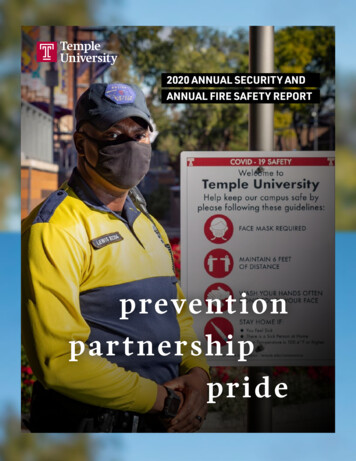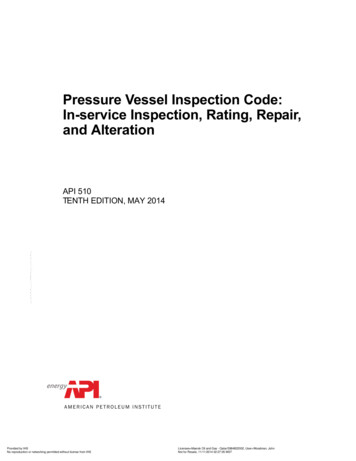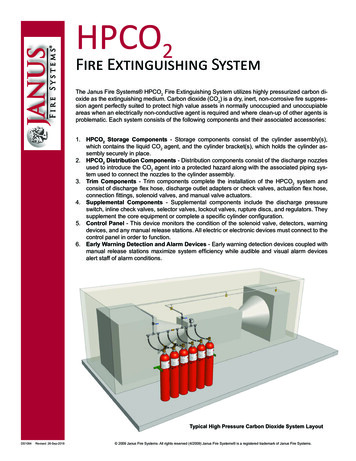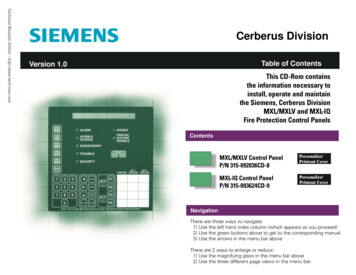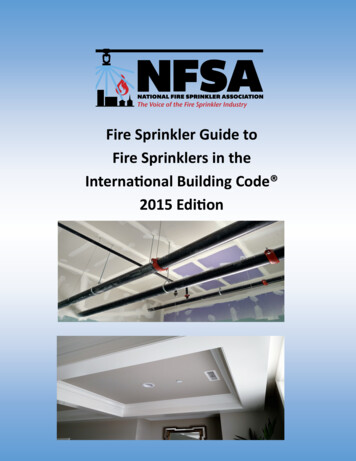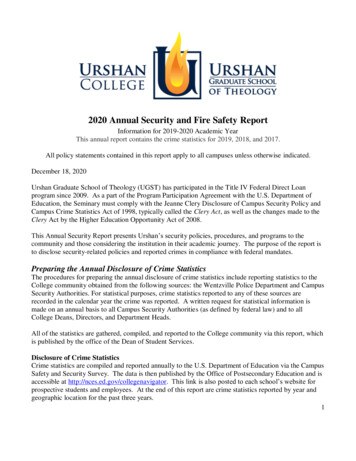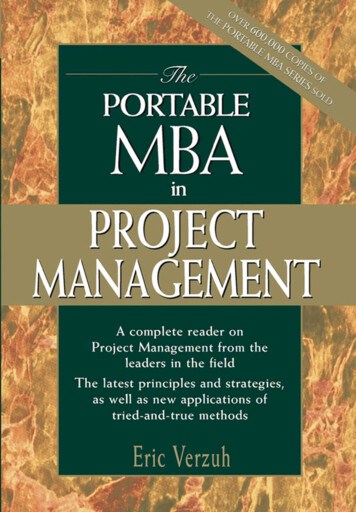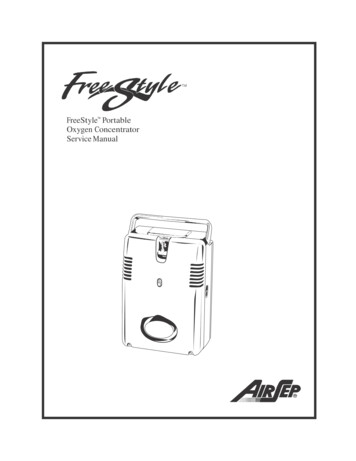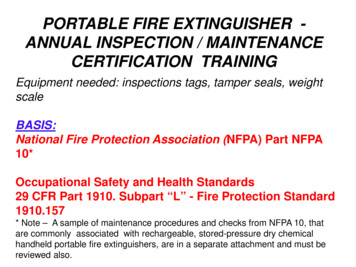
Transcription
PORTABLE FIRE EXTINGUISHER ANNUAL INSPECTION / MAINTENANCECERTIFICATION TRAININGEquipment needed: inspections tags, tamper seals, weightscaleBASIS:National Fire Protection Association (NFPA) Part NFPA10*Occupational Safety and Health Standards29 CFR Part 1910. Subpart “L” - Fire Protection Standard1910.157* Note – A sample of maintenance procedures and checks from NFPA 10, thatare commonly associated with rechargeable, stored-pressure dry chemicalhandheld portable fire extinguishers, are in a separate attachment and must bereviewed also.
TRAINING OBJECTIVES:After this training you should be able to: IDENTIFY common types of fire extinguishers,classes, ratings, and their components EVALUATE what type of extinguishers areneeded at what locations. INSPECT if the extinguishers are in workingcondition, damaged, or otherwise need service APPLY inspection tags and/or annotate that theannual inspections have been performed.
TRAINING COMPONENTS Review of NFPA 10 (included with thispresentation) Review of this PowerPoint presentation View video of annual maintenanceprocedures linked to this presentation Take Exam and send it to the SafetyOfficer
Portable FireExtinguishers Can be carried to a fire Weigh* from 5 to 30 pounds Have a NFPA Class Have a NFPA Rating*The size of fire extinguishers is expressed in weight, more specificallyin pounds (lbs.). The fire extinguisher weight indicates how muchextinguishing agent it can hold, not the total weight of the extinguisher.
Portable FireExtinguishersLIMITED IN: Capacity - 1.5 to 25 lbs.ofextinguishing agent Range - Typically 3 to 15 feet Duration - Discharge theircontents in only 5 to 30 seconds!
EXTINGUISHERS1. ARE DESIGNED TO FIGHT A CERTAIN CLASS OR CLASSESOF FIRE2. ARE RATED FOR THE SIZE FIRE THEY ARE EXPECTED TOEXTINGUISH3. MUST BE APPROVED BY A NATIONALLY RECOGNIZEDTESTING LABORATORY SUCH AS:1. Underwriters Laboratory (UL)2. Factory Mutual Research (FM)3. U.S. Coast Guard (USCG) for marineapplications
FIRES ARE CLASSIFIED BY THETYPE OF FUEL BURNINGFUEL CLASSIFICATIONS Class A: ORDINARY COMBUSTIBLES - Wood, Paper,Cloth, Trash, Plastics – Solids that are not metals. Class B: FLAMMABLE LIQUIDS AND GASES - Gasoline,Oil, Grease, Acetone, Propane. Class C: ELECTRICAL – Energized ElectricalEquipment; as long as it is “plugged in”. Class D: COMBUSTIBLE METALS, such as magnesium,titanium, zirconium, sodium, lithium, and potassium. Class K: COOKING MEDIA - Grease, Fats and Oils.
Fire Extinguisher RatingsThe Letters A,B,C,D,KRepresent the types of fire or class, for which the extinguisher hasbeen approved for. Some extinguishers are classified for only one typeof fire, others may be classified for multiple types of fires.For Example the Number in Front of the AClassification Is the Rating and Indicates how muchwater the extinguisher is equivalent to, and represents 1.25gallons of water for every unit of one.So .a 4-A rated fire extinguisher would be equalto five gallons of water (4 x 1.25 5)
Fire Extinguisher Ratings Continued:The Number in Front of the B (flammable liquid)Classification - Represents the area in ft2 of aflammable liquid one-inch deep, that a non-expertuser should be able to extinguish.Example:For an extinguisher rated 10-BC; A non-expert usershould be able to put out a flammable liquid fire thatis as large as 10 ft2 (square feet).
Fire Extinguisher Ratings Continued:C, D and K classified extinguishers are not generallygiven a numerical rating.The C classification indicates that the agents in theextinguisher are non conductive – for an electrical fire.The D classification indicates that the agents in theextinguisher can be used for flammable metals.The K classification indicates that the agents in theextinguisher can be used for kitchen fires involvingcooking oils and deep fryers. Normally commercialuse.
Types of Fire ExtinguishersOrdinary CombustiblesClass A: Wood, Paper, Cloth, Trash, PlasticsDry Chemical Extinguisher (Class ABC)Coats Fuel with Flame RetardantAir Pressurized Water Extinguishers(Class A Only)Extinguishes by cooling the surface of the fuel
Types of Fire ExtinguishersFLAMMABLE LIQUIDS AND GASESClass B:CO2 - Carbon DioxideExtinguisher(Class BC)Displaces OxygenGasoline, Oil, Grease, some Paints, Solvents,Propane.ORDry ChemicalExtinguisher(Class ABC)Coats Fuel with Flame Retardant
Types of Fire ExtinguishersElectrical EquipmentClass C:Energized Electrical Equipment including wiring,fuse boxes, circuit breakers, machinery and appliancesCO2 - Carbon DioxideExtinguisher(Class BC)Displaces OxygenORDry ChemicalExtinguisher(Class ABC)Coats Fuel with Flame Retardant
Types of Fire ExtinguishersCombustible MetalsClass D:Combustible metals, such as magnesium, titanium,zirconium, sodium, lithium, and potassium.Sodium ChlorideBased Dry Powder(Class D Only)Heat from the fire causes it tocake and form a crust excludingair and dissipating heat fromburning metal.
Types of Fire ExtinguishersFires Involving Cooking MediaClass K:Vegetable or Animal Fats and OilsWET CHEMICAL - Stored Pressure Fire Extinguisher(Class K Only*) *Some newer models are also rated AExtinguishes by Saponification and Cooling ofCooking Oil Fires
Fire Extinguisher Weight vs Rating The weight of the extinguisher is based on the amount of theextinguishing agent.Typically you will see 2.5, 5, or 10 lb. fire extinguishers in ourfacilities.This if different than it’s rating.For Example: A typical 5 lb. dry chemical fire extinguisher is rated at3-A:40B:C Meaning that it can be used for A,B, or C, classes of fires.Meaning that it has 5 lbs. of agent in the extinguisher3A meaning it is equal to 3.75 gallons of water for a paper/wood fire40B means a non-expert user should be able to put out a flammableliquid fire that is as large as 40 ft2.C meaning it is non-conductive and acceptable to use for an electrical fire.This type of extinguisher is called a Multi-Purpose ABC Dry ChemicalFire Extinguisher and is the recommended and most common typefound in Service facilities.
ABC Dry Chemical FireExtinguisher Ratings Typical 2.5 lb. extinguisher is rated at 1A:10B:C Typical 5 lb. extinguisher is rated at 3A:40B:C Typical 10 lb. extinguisher is rated at 4A:60B:C
NFPA Extinguisher Class and RatingRequirements by Location Light Ordinary Hazard Occupancy (Office)– 2A:10B:C (at 75’) Moderate Hazard Occupancy (Most Shops, PoleBarns)– 2A:10B:C (at 30’), 2A:20B:C (at 50’) High Hazard Occupancy (Vehicle Repair Bay,Welding Area, Flammable Storage)– 4A:80:B:C (at 50’), 4A:40B:C (at 30’)NOTE: These requirements can be met by having multipleextinguishers. Example: Two 10 lb. ABC type dry chemicalextinguishers 30 ft. apart rating of 6A:80B:C. (also see next page)
Minimum Recommended Fire Extinguisher Sizes PerLocation - ABC Dry Chemical (Recommended) Offices – 5 lb. within 75’ from any point.Pole Barns – 5 lb. within 50’ from any point.Shops – 5 lb. within 50’ from any point.Garage Bays* – 10 lb. within 50’ from any point.Flammable Storage Areas** – 10 lb. within 30’ from any point.Residences – (each floor must have one)– 5 lb. in Basement and 1st floor, accessible to Kitchen/Garage– 2.5 lb. Second/third floors*When work is conducted handling flammables, e.g. gas tank removal, have an additional fireextinguisher on hand. Requirements may also be met when fueling vehicles by adding theextinguisher rating of the unit in the vehicle to the rating of the one mounted for the fuel tank.**For flammable storage areas there are other requirements as well:–––Within 10 feet of HazMat bldg. 10 lb. or a 5 lb. with another within 30-50 feetBetween 25-75 feet from aboveground fuel dispensing tanks. 10 lb. or 5 lb. with another within 30-50 feet.Between 10-25 feet from an indoor flammable cabinet. 10 lb. or a 5 lb. with another within 30-50 feet
Vehicle Extinguisher Requirements 243 FW 1.12 Sedans, station wagons, light trucks, OURV’s, and medium-duty trucks less than 26,000 lbs.GVWR used for field work or carrying passengers must be equipped with not less than a 2 ½lb. ABC type fire extinguisher rated at 1A:10BC.All commercial motor vehicles must be equipped with not less than a 5 lb. ABC type fireextinguisher rated at 3A:40BC.All heavy duty motor equipment must be equipped with not less than a 2 ½ lb. ABC type fireextinguisher rated at 1A:10BC unless the equipment is used in a combustible environment or ina manner that may generate sparks or heat. If the equipment is operated under theseconditions, it must be equipped with a fire extinguisher not less than a 10 lb. ABC type rated at4:A:60BC.The operator must adequately secure each fire extinguisher within or on the vehicle by theplacement of the unit or using a cage, harness, or strap that protects the extinguisher andvehicle occupants.The fire extinguisher can notbe loose to become aprojectile during suddenimpact or stop.
Vehicle Extinguisher Requirements (continued) There must be a fire extinguisher rated not less than 10B at job sites that are within 50 feet ofwhere more than 5 gallons of flammable or combustible liquids or 5 pounds of flammable gasare being used. This requirement does not apply to the integral fuel tank of motor vehicles.Operators may use combinations of smaller fire extinguishers to achieve the larger requiredsize (e.g., two 5 lb. rated extinguishers one 10 lb. extinguisher).Watercraft fire Protection Equipment, 241 FW 1 At a minimum, one 2.5 lb. USCG-approved ABC (recommended) or BC type fire extinguisherwith a 1A:10B:C, or 10B:C rating must be installed at a location that is readily accessible on allmotorboats less than 26 feet in length. All motorboats from 26 feet to 40 feet in length musthave two, and motorboats 40 feet to 65 feet must have three.Does not have to bewhite. Some marinerated extinguishersare red.
FIRE EXTINGUISHER INSPECTIONS Monthly Visual Inspection: 1910.157(e)(2) - Portable extinguishers or hoseused in lieu thereof under paragraph (d)(3) of this section shall be visually inspectedmonthly.–––– Confirm the extinguisher is visible, unobstructed, and in its designated location.Verify the locking pin is intact and the tamper seal is unbroken. Examine the extinguisherfor obvious physical damage, corrosion, leakage, or clogged nozzle.Confirm the pressure gauge or indicator is in the operable range or position, and lift theextinguisher to ensure it is still full.Make sure the operating instructions on the nameplate are legible and facing outward.Annual Maintenance Inspection: 1910.157(e)(3) - The employer shallassure that portable fire extinguishers are subjected to an annual maintenancecheck. Stored pressure extinguishers do not require an internal examination. Theemployer shall record the annual maintenance date and retain this record for oneyear after the last entry or the life of the shell, whichever is less. The record shall beavailable to the Assistant Secretary upon request.–See the Following Slides for the Requirements of the Annual Maintenance Inspection.
PORTABLE FIRE EXTINGUISHERSNFPA 10 and General-IndustryRequirements Under OSHA – 29CFR 1910.157Dry Chemical Monthly –Inspection (visual) Annually -Annual Inspection/Maintenance Six Years -Disassemble and Recharge Twelve Years - Hydrostatic Test**It is usually less costly to purchase new ones from GSA rather than pay forhydrostatic testing, especially for smaller extinguishers.
PORTABLE FIRE EXTINGUISHERS (cont.)Carbon Dioxide Monthly –Inspection (visual) Annually -Annual Inspection/Maintenance Five Years -Recharge and Hydrostatic TestDISPOSABLE * Dry Chemical Monthly –Inspection (visual) Annually -Annual Inspection/Maintenance Twelve Years -Dispose*Note: Disposable Dry Chemical Extinguishers DO NOT need to berecharged at 6 years. They can not be Hydrostatically tested so they aredisposed of, or used for training, after 12 years.
ExtinguisherCommon features Locking pin with anti-tamper sealCarrying handle / operating leverPressure gaugeLabel :––––Type (Water, C02, Dry Chemical)Classification (A, B, C)NFPA capacity RatingInstructions Discharge nozzle or horn
Annual Maintenance/InspectionWhat does annual maintenance of portable fire extinguishers involve? Make sure the extinguisher is the proper type for the location, in the properplace, visible, and on a hanger or secured in vehicle. Make sure it has not been recalled. Go to http://www.cpsc.gov/en/Recalls/ andconduct a search by brand and model number if needed.
Annual Maintenance/Inspection (cont.) Check the gauge to make sure it is chargedand not damaged. Does the unit have theproper hanging brackets? Complete an external examination of theshell and components for damage, corrosion,dents, or wear. Examine the handle including the pin andanti-tamper seal. Remove seal. Remove the hose and inspect for anyblockage from dirt or insects. Look insidethe port to see any signs of powder are leftover from a discharge. If there is any evidence that it has been usedit must be recharged.
Annual Maintenance/Inspection (cont.)Review the manufacturer date or label to see if needs a recharge orhydrostatic test. If either is required send it out for service or purchase anew unit. When it is out for service you must replace it with a useableextinguisher of the proper size in the interim.How can I tell how old my Fire Extinguisher is? On the chrome liquid types, that date is usually found on the hanger loop.On the regular ABC, BC, or Halon extinguishers that date is usually found on thelabel, howeverSome manufacturers stamp the date in the "boot" located around theextinguisher base or right on the base itself.On the CO2 type extinguishers this date is found stamped around the shouldernear the top. There may be multiple date stamps, look for the most recent.
Annual Maintenance/Inspection (cont.)Make sure the labels are in good shape, legible, havemanufacturer information, are UL, FM, or USCG listed.This was recharged andhydrostatically tested inJanuary of 2007.
Annual Maintenance/Inspection (cont.)Weigh* the fire extinguisher to ensure it hasnot lost any of its charge. It must weigh thesame as the gross weight listed on the label,not the agent weight. Example; a typical 5 lb.ABC Dry Chemical Extinguisher has 5 lbs. ofextinguishing agent but weighs 9 lbs. 1 oz.*NOTE: This is required for CO2 typeextinguishers and optional for Dry Chemical.
Annual Maintenance/Inspection (cont.) Remove the old anti-tamper seal.Pull the pin out to ensure it comes out easily.Make sure handle and lever operate freely but DO NOT dischargethe fire extinguisher. Replace pin.Attach a new anti tamper seal. Make sure it is the proper type thatwill break away easily. NO TIE WRAPS that need to be cut.Anti-tamper seal
Annual Maintenance/Inspection (cont.) Annotate on the tag the date it wasmanufactured and/or last hydrostatictest date. If there is no section formanufacturer date annotate that in theHydrostatic test line with a note.Annotate on the tag the date of theannual inspection and by whom. If ithas been recharged, transfer thatinformation from the previous tag orlabel but keep that tag or label with theunit.If it is over 6 years old (dry chemical) itneeds recharging unless it is adisposable (12 yrs.) or there is aseparate tag on it indicating a rechargeor hydrostatic test date.If it does not pass inspectionReplace the unit or send itout for servicing if needed
If you have any questions, pleasecontact your respective RegionSafety Manager.Thank you.
Portable extinguishers or hose used in lieu thereof under paragraph (d)(3) of this section shall be visually inspected monthly. – Confirm the extinguisher is visible, unobstructed, and in its designated location. – Verify the locking pin is intact
